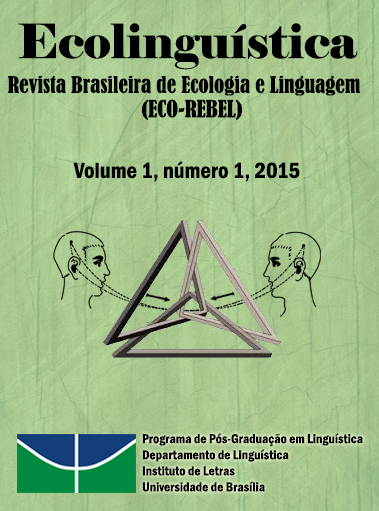O ambiente como argumento final na imprensa brasileira
Keywords:
Linguistics, ecolinguistics, media, environmental discourse, enunciation.Abstract
This article analyses, in the field of ecolinguistics, a news story published in a Brazilian newspaper, about a prominent civil servant detained by the police. It recognizes the centrality of enunciation for linguistic analysis and aims at identifying the ideology underlying its modalisation. In our point of view the analysed news simplifies reality, creating simplistic dichotomies and, in a sense, it manipulates the facts to create spectacularisation and attract the newspaper reading public. In detail, it evokes the environmental interdiscourse which runs the public sphere to, by association, enhancing the targeted person image and then reverse the appraisal and create a strong dysphoric image of him. The environmental interdiscourse is then given for granted, indisputably accepted by all citizens, and environmental activism is presented as a higher trait of individual’s character. Despite being built like a news story, with objectified text feature, the article in question is clearly a public assessment, replacing the court by the public opinion in order to charge the targeted person, without ever having heard him or considered his personal defence.
Downloads
References
AMOSSY, R. (2010). La présentation de soi. Ethos et identité verbale. Paris: PUF.
BAKHTINE, M. (1981 (1930)). La structure de l’énoncé. In T. Todorov: Mikhail Bakhtine et le principe dialogique, suivi de Écrits du Cercle de Bakhtine. Paris: Seuil, pp. 287- 316.
BENVENISTE, E. (1975). Problèmes de linguistique générale I. Paris: Gallimard.
CHARAUDEAU, P. (1997). Le discours d’information médiatique. La construction du miroir social. Paris: Nathan.
CHARAUDEAU, P. (2006). Discurso das mídias. São Paulo: Contexto.
CHARAUDEAU, P. (2008). Linguagem e discurso: modos de organização. São Paulo: Contexto.
COUTO, I. H. (2013). O que vem a ser a ecolinguística, afinal?. Cadernos de linguagem e sociedade, 14 (1), pp. 275-313.
COUTO, I. H. (2013a). Análise do discurso ecológica. Disponível em:
http://meioambienteelinguagem.blogspot.com.br/2013/04/analise-do-discursoecologica.html.
Consultado em 13/01/2015.
COUTO, I. H. (2014). Linguística ecossistêmica crítica ou análise do discurso ecológica. Disponível em http://aarvinha.blogspot.com.br. Consultado em 13/1/2015. (Também disponível em: Couto, Elza; Dunck-Cintra, Ema; Borges, Lorena (orgs.). Antropologia do imaginário, ecolinguística e metáfora. Brasília: Thesaurus, pp.
-41).
COUTO, I. H. (2014a). Ecossistema integral da língua. Disponível em:
http://meioambienteelinguagem.blogspot.com.br/2014/10/ecossistema-integral-dalingua.html. Consultado em 13/01/2015.
DONDIS, D. A. 2007. Sintaxe da linguagem visual. São Paulo: Martins Fontes.
FONSECA, J. (1992). Heterogeneidade na Língua e no Discurso. In: FONSECA, J. Linguística e Texto / Discurso. Teoria, Descrição, Aplicação. Lisboa / Nice: Instituto de Cultura e Língua Portuguesa / Universidade de Nice, pp. 249-292
HARRÉ, R.; BROCKMEIER, J.; MÜHLHÄUSLER. P. (1999). Greenspeak. A Study of Environmental Discourse. Thousand Oaks / London / New Delhi: Sage.
JUNG, M. (2001). Ecological Criticism of Language. In FILL, A.; MÜHLHÄUSLER, P. (2001). The ecolinguistics reader. Language, ecology and environment. London / New York: Continuum, pp. 270-285.
KILLINGSWORTH, M.; PALMER, J. (1992). Ecospeak. Carbondale: Southern Illinois University Press.
KOREN, R. (2006). La responsabilité des Uns dans le regard des Autres: l’effacement énonciatif au prisme de la prise de position argumentative. Semen, 22, Énonciation et responsabilité dans les médias [En ligne], mis en ligne le 2 mai 2007. URL: http://semen.revues.org/document2820.html. Consultado em 13/01/2015.
MOIRAND, S. (1999). Les indices dialogiques de contextualisation dans la presse ordinaire. Cahiers de praxématique, 33. pp. 145-184.
MOIRAND, S. (2006). Responsabilité et énonciation dans la presse quotidienne: questionnements sur les observables et les catégories d’analyse. Semen, 22, Énonciation et responsabilité dans les médias, [En ligne], mis en ligne le 16 mai 2007. URL: http://semen.revues.org/document2798.html. Consultado em 13/01/2015.
RAMOS, R. (2007). Heterogeneidade enunciativa no discurso sobre o ambiente na imprensa portuguesa: funcionamento e efeitos do discurso directo. Linguagem em (Dis)Curso, 7:1, pp. 45-70.
RAMOS, R. (2009). O discurso do ambiente na imprensa e na escola. Uma abordagem linguística. Lisboa: Fundação Calouste Gulbenkian / Fundação para a Ciência e a Tecnologia
RAMOS, R. (2009a). The Organization and Functions of the Press Dossier: The Case of Media Discourse on the Environment in Portugal. In: BAZERMAN, C.H. ; BONINI, A.; FIGUEIREDO, D. (Eds.). Genre in a Changing World. Fort Collins, Colorado / West Lafayette, Indiana: The WAC Clearinghouse and Parlor Press, pp. 223-242.
RAMOS, R. (2011). Contributos para a caraterização da retórica ambiental na imprensa generalista portuguesa. Revista Galega de Filoloxia, 12, pp. 155-176.
RAMOS, R. (2011a). Vozes políticas no discurso mediático sobre o ambiente. In: MACEDO, M. G. ; SOUZA, C. M.; MOURA, V. (Org.). XII Colóquio de Outono. Vozes, discursos e identidades em conflito. Braga: Centro de Estudos Humanísticos da Universidade do Minho / Edições Húmus, pp. 265-279.
RAMOS, R. (2012). Editoriais de edições especiais “verdes” na imprensa periódica portuguesa contemporânea. O caso da revista “Visão”. Caderno Seminal, 18, pp.186-200.
RAMOS, R. (2013). O rei de Espanha foi caçar elefantes. A construção discursiva do evento nos media portugueses. Cadernos de Linguagem e Sociedade, 14:1, pp. 17-40.
RAMOS, R.; CARVALHO, A. (2008). Science as Rhetoric in Media Discourses on Climate Change. In: DAM, L.; HOLMGREEN, L.-L.; STRUNCK, J. (Eds.). Rhetorical Aspects of Discourses in Present-Day Society. Newcastle upon Tyne: Cambridge Scholars Publishing, pp. 223-247.
Downloads
Published
How to Cite
Issue
Section
License
Authors who publish in this journal agree to the following terms:
Authors retain copyright and grant the journal the right of first publication. The work is simultaneously licensed under the Creative Commons Attribution License allowing the sharing of the work with acknowledgment of the authorship of the work and initial publication in this journal.
Authors are authorized to enter into additional contracts separately for non-exclusive distribution of the version of the work published in this journal (e.g., publishing in institutional repositories or as book chapters), with acknowledgment of authorship and initial publication in this journal.
Authors are allowed and encouraged to post and distribute their work online (e.g., in institutional repositories or on their personal page) at any point before or during the editorial process, as this can bring about productive revisions as well as increase impact.
Citation of published works (See The Effect of Free Access).



3.png)



